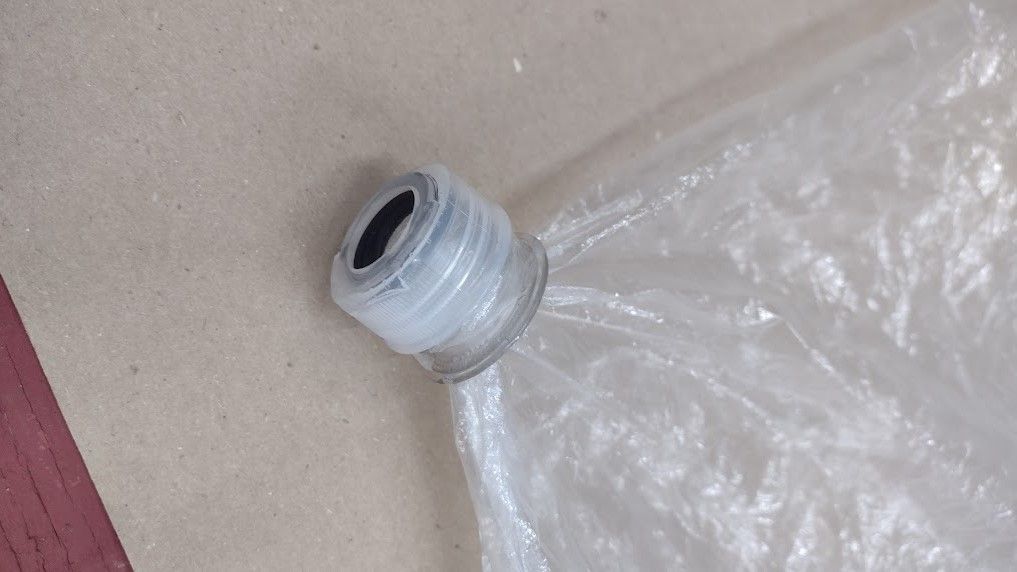In Search of the Perfect Pump Sack

I HATE inflating my sleeping pads by blowing into them. I hate seeing condensed water vapor clinging to the inside walls - where I can't easily get it out - where it adds weight (!), and breeds mold and other nasties. Thankfully most pad manufacturers agree with me and provide something like the sack pictured above along with the pad. This is a good, but it could be better in many ways. Firstly, it's dead-wight. Secondly, it's not a waterproof material. (If it was, it could serve double-duty as a waterproof stuff sack.) Thirdly - the size is a bit odd. Pretty large, but too small to serve as a pack liner.
I came across a suggestion on one of the various Facebook groups I'm part of to turn a standard nylofume or trash bag pack liner into a pump sack. Videos like this showed how. I was stoked. At the time I had a Thermarest with the old-style valve, so this worked perfectly. The nylofume bag I was already using was 26 grams. The weight after the mod was 38 grams. The Thermarest pump sack I was using at the time (which I stuffed with clothes to make a pillow) was 52 grams. So, for a few minutes of my time I saved 40 grams (over an ounce) and made my pack liner a dual-purpose item. (At the same time, I realized that I had the empty tent stuff-sack that I could stuff with clothes instead to make a pillow.)


Then I ended up getting a Thermarest with the new-style "wing-lock" valve. What to do, what to do?
My first attempt was to fabricate my own pump sack by harvesting the fitting off of a stock sack supplied with the pad. I had some left-over custom-printed 1.1 OSY ripstop silpoly material from a project. I sized the bag to fit a frameless pack I have. It worked, but I quickly learned that making the bag smaller (to save a few grams in weight) was short-sighted. The extra size of the Nylofume pack liner had benefit when rolling it up and stuffing it inside the pack. It also had the benefit of being a larger bag - therefore could pump more air in one filling. Total weight: 41 grams. So, for 3 grams more than the nylofume, I got vanity and durability.

Then I found a guy on a Facebook group who could 3D print the connection port I would need out of a flexible material that could be adhered directly to Nylofume. Only $10 for 2 of them. What a deal! I wanted to go "UL" on this one, so I shortened the bag (didn't learn my lesson from the leaf bag). Total weight: 25 grams. I was styling, until I ripped the bag through carelessness.

Which brings me to my next evolution: another custom-printed silpoly material bag, but this time with a lighter 0.93 OSY membrane silpoly.
This evolution would be more durable than the Nylofume, and would be sized to fit my largest pack. The 3D printed connection worked OK, but not as well as the connection on a stock bag. And rather than harvest the fitting off of a stock bag by removing stitching and then manually stitching it back to the material, I just cut a squre of the stock grey bag out and sewed it to thge new bag. To top this bag off, I added a draw-string and cord lock at the top so that it would be easier to gather/close for pumping purposes when filling a pad, and seam sealed it. Total weight: 45 grams.
And Bonus! Because it's so large it can serve a third duty besides being a pack liner and a pump sack. I use it as a ground cloth in the vestibule of my tent.


I am now gathering materials to make the same type of pump sack/pack liner for Tina and her Sea-to-Summit Ether Light XT. She's chosen a different motif for a printed material - a sunset scene she took last time we were out to Big Bend National Park.
Hope this helps.
Keep hiking my friends

